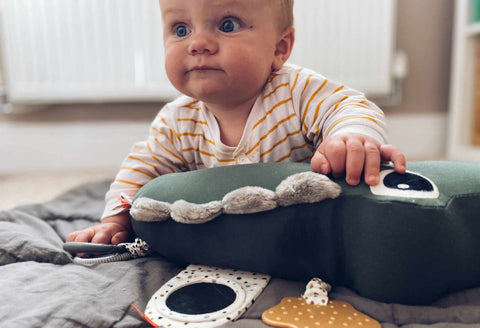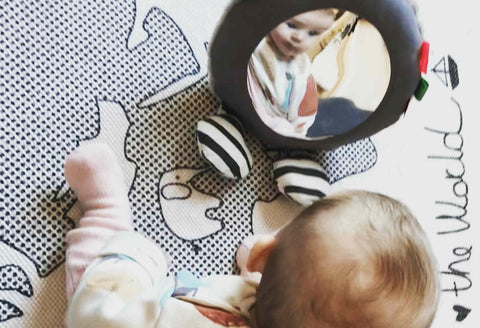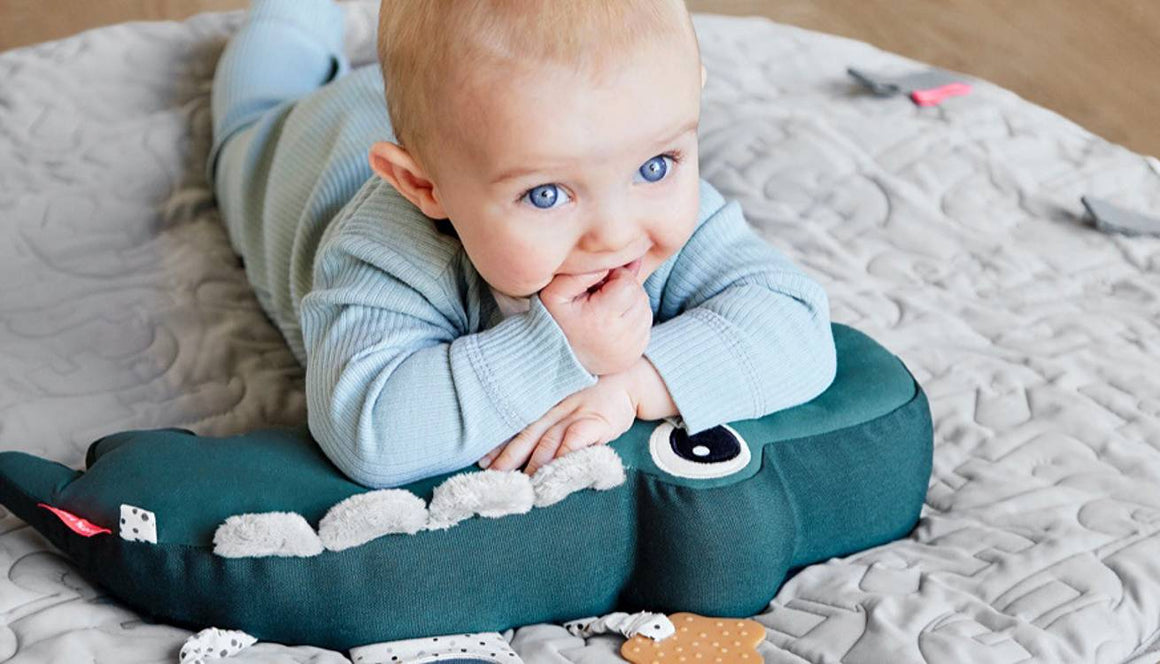Your health visitor never shuts up about it, but your Mum breezily declares: "We never had it in my day". So, what is tummy time, why should you do it, and how? Here are some helpful answers to 10 of the most frequently asked tummy time questions.

So, what is tummy time, why should you do it, and how?
1. Why is it important?
We all know babies should go on their backs to sleep, to guard against cot death, or sudden infant death syndrome (SIDS), to give it its proper name. Since the Back to Sleep campaign was launched in the 1990s, SIDS rates have dropped an amazing 81% in the UK. This great public health success story has, however, meant babies spending most of their time on their backs, in their cots, bouncy chairs, and car seats. As a result, an increasing number are showing some delay in reaching certain physical milestones.
For example, estimates say nearly half of the babies under 12 months develop a degree of positional plagiocephaly - aka 'flat head syndrome' - a flattened spot, either on one side or the back of the head. It's nothing to fret about in the vast majority of cases: it won't cause pressure on their brain or affect their development in the long run. But still, though it might only be cosmetic, most parents would rather avoid it. Another potential side-effect of back sleeping is torticollis: neck stiffness that makes it hard or painful for your baby to turn their head.
So THAT'S why your health visitor has got such a bee in their bonnet about getting into a good tummy time routine. It doesn't just prevent (and treat) both flat heads and stiff necks. It builds up your baby's shoulders and back and strengthens and lengthens their core and their hip flexors. It helps them open up their hands and increases their gross motor and visual skills, including depth perception, plus it's great for their whole vestibular system (the sensory network that tells them where their body is in space).
And finally - and this is a really important bit - when your baby learns to make their body do new things, it gives them a major sense of accomplishment. So tummy time gives them the confidence they need to try new skills.
2. So, when can I start?
From day one! Begin as soon as you can. Be careful though to only try tummy time when you’re both awake and you can watch them closely.
3. How long should I do it for?
Start with a 'little and often' approach. At first try for a minute or so, two or three times a day. As they get used to it, build it up. By the end of the first month, aim for 10 minutes a day. Experts recommend that you work up to about 1 hour a day by the time they're 3 months old.
4. What’s a good time of day to try it?
Anytime that you are both rested and alert - maybe after their nap or a nappy change. A watch out, though. Placing a baby on their belly right after a feed will put pressure on their stomach, which might cause what you've just lovingly fed to them to bounce back up. So leave 20 to 30 minutes after a feed to avoid discomfort - and mess!
5. Where is best?
At first, you'll probably be the 'mat' and your newborn will be on your chest. When you're ready to hit the floor, place them on something clean and comfortable in a low, firm spot. Never put a baby face down on any soft surface, or near cushions and duvets that could inhibit their breathing. Also avoid sofas, beds, or raised change mats that they could roll off and, if you have other children or pets, make sure they're well out of the way.
An exercise ball, if you have one, is another fun option. Hold your baby on top, while you roll the ball gently backwards and forwards. The gentle motion is great for stimulating their vestibular (balancing) system. Also, don't forget to get outdoors! When it's warm enough, take a rug or towel with you to the park and your baby will get to enjoy tummy time with all the added stimulation of the sights, sounds, and smells of the big wide world.
6. What equipment do I need?
You don't have to go out and buy a whole playground of mats and toys. A clean towel or throw is perfectly good to lie on. If you like, you can of course buy a tummy time pillow, which raises their upper body and will have added tactile elements like crinkly stuff, textures, mirrors, and tags. But a rolled-up towel placed under their chest and armpits will be just as effective in helping them lift their head more easily. The main idea is to put bright and appealing-looking books or toys around them, just within reach, to give them stimulation and the enjoyment of grasping and reaching.

7. Is there a recommended technique?
Newborn - 1 month: With a very young baby, try tummy time first when you're reclining, with your baby on your chest facing you. Smile, talk, or sing softly to them: eye and body contact are comforting and reassuring and great for bonding (which is brilliant for Dads and partners too). Or, you can try putting them across your lap, or walk around with them across your forearm in 'football hold'. (Dads often love this one!) As your baby gets a little older and stronger, you can lie back so you're flat on the floor and maybe bring your knees up and put them on your raised shins. Once they’re totally happy in these positions, you’re ready for the floor.
1 - 4 months: By this stage, they should be able to lean on their arms a little, which means they're ready for tummy time on the floor. Get down and lie next to them, shake maracas, make goofy noises and expressions, or sing songs. Don't worry if you feel silly, they won't think so (!) and you'll help distract them from their tough workout.
Around 6 months: They'll be beginning to pivot on their belly and use their arms to reach in front of them or to the sides. You can start to up the physical challenge by playing games like ‘Superman’, where you hold them under their arms and gently lift them so they stretch into the flying superhero’s pose. This is great for general upper body and neck strength.
Tummy time strengthens and lengthens their core & hip flexors, helps them open up their hands, and increases their gross motor skills & visual skills, including depth perception, plus it's great for their vestibular system.
8. My baby is 2 months old. Is it too late to start?
No! Tummy time isn’t a football club with a transfer window. Start whenever you like!
9. Do I have to actively play with them the whole time?
Ideally, you would play with them all the time they're on the floor. But for an older baby, you can step back if they’re somewhere safe and flat, with enough toys around them. You must stay close, though, so you can observe them at all times. But let older siblings join in and help with the entertainment. For a sall baby, they're usually the best show in town!

10. What if they don’t like it?
Newborn babies can take a while to get used to tummy time. If they're fussing, hold them upright and cuddle them. Then try again and make sure you give them lots of distraction and stimulation, by singing or holding up toys or books with bright colours or patterns. The point is to keep persevering and to try to have some tummy time each day. Once your child is rolling over and independently spending time on their stomach, usually by 6 months old, you can stop dedicated tummy time - they'll likely be eager to get off on their adventures anyhow!
FURTHER READING:
NCT: Top Tips For Tummy Time
Bespoke Family: Tummy time!
We hope that has helped to de-mystify tummy time and answer some of your (or your Mum's!) questions. And remember, if you need advice on anything, our Live Chat Team is always here to help, from 9am to 5pm, weekdays. Just hit that purple button, bottom right.
Picture credit:
Newborn: Hollie Santos on Unsplash












